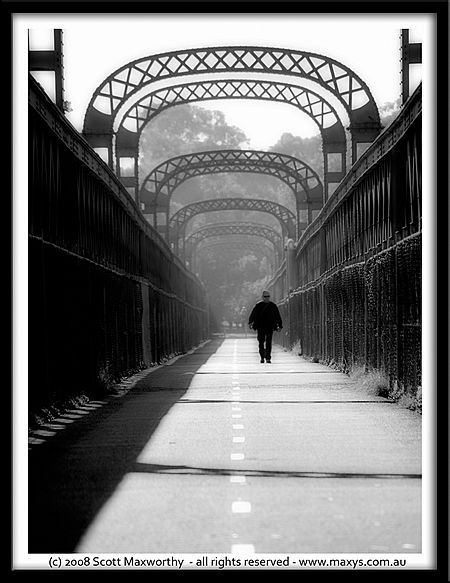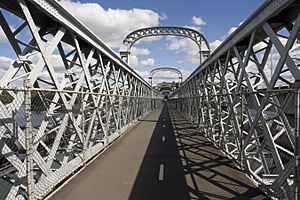Old Como railway bridge facts for kids
Quick facts for kids Old Como railway bridge |
|
|---|---|
 |
|
| Coordinates | 33°59′42″S 151°04′15″E / 33.9951°S 151.0708°E |
| Carries |
|
| Crosses | Georges River |
| Locale | Oatley, Georges River Council, New South Wales, Australia |
| Owner | Sydney Water |
| Preceded by | Woronora River Bridge |
| Followed by | Como railway bridge |
| History | |
| Designer | John Whitton |
| Contracted lead designer | Department of Railways |
| Construction begin | 1883 |
| Construction end | 1885 |
| Official name: Como Rail Bridge; Old Como Rail Bridge | |
| Type: | State heritage (built) |
| Designated: | 15 November 2002 |
| Reference #: | 1624 |
| Type: | Railway Bridge / Viaduct |
| Category: | Transport - Rail |
| Builders: | C. and E. Millar |
The Old Como railway bridge is a special bridge in Oatley, New South Wales, Australia. It used to carry trains over the Georges River. Today, it's a footbridge for people and bikes, and it also carries water pipes. The bridge was built between 1883 and 1885. It was designed by John Whitton and the Department of Railways. Sydney Water now owns the bridge. It was added to the New South Wales State Heritage Register in 2002 because it's an important part of history.
Contents
History of the Old Como Bridge
How Oatley Got Its Name
The suburb of Oatley is named after a man named James Oatley. He was a clock maker who arrived in Australia in 1815. He was given land grants, including one near the Georges River in 1833.
James Oatley never lived on this land. However, when the railway line was built through his old property in the 1880s, the new train station was named Oatley. This is also how Oatley Bay and Oatley Park got their names.
Building the Bridge
The Old Como railway bridge was finished in 1885. It was built for the original Illawarra railway line. This bridge is a great example of a single-track steel lattice girder bridge from the 1870s and 1880s.
It is the longest single-track steel lattice girder bridge in New South Wales. It is also the only one of its kind within 250 kilometres (about 155 miles) of Sydney.
A Busy Bridge
Even though it was new, the bridge quickly became a problem. The railway line on either side of the bridge had two tracks. But the bridge itself only had one track. This meant trains had to share the single track on the bridge. This was called a "gauntlet track." It allowed trains to cross safely in both directions.
New Uses for the Bridge
Between 1935 and 1942, Sydney Water (then called the Metropolitan Water Sewerage and Drainage Board) built a new water pipeline. This pipeline carried water from the Woronora Dam to reservoirs in Penshurst.
The pipeline was placed on the Como railway bridge. To keep the bridge balanced, the large pipeline was split into two smaller pipes. One pipe was placed on each side of the bridge.
In 1972, a new, wider bridge was built next to the old one. This new bridge could carry two train tracks. The old bridge was no longer needed for trains. So, Sydney Water took over the old bridge.
In 1985, the old railway tracks were removed. The bridge was then turned into a cycleway and footpath for people to walk and ride bikes. This happened 100 years after the bridge was first built!
What the Bridge Looks Like
The Old Como railway bridge is made of iron lattice girders. It used to be a railway bridge. Now, the railway tracks are gone. Instead, there is a paved path for walking and cycling.
Sydney Water still uses the bridge to carry a water pipeline across the Georges River.
Changes Over Time
The bridge has been changed a few times since it was built:
- 1926: Parts of the bridge were raised to support electrical wires for trains.
- 1935-1942: The large water pipeline was added across the bridge.
- 1985: The railway tracks were removed, and the bridge became a path for people and bikes.
- 2003: Wooden walkways and steel handrails next to the pipeline were removed.
Why the Bridge is Important
The Old Como railway bridge is very important for several reasons. It is the longest single-track lattice girder bridge in New South Wales. This makes it a rare example of this type of bridge.
The bridge helped open up the southern suburbs of Sydney in the 1880s. It was a key part of the early railway system. Even though trains no longer use it, the bridge still helps carry water for Sydney. It also provides an important path for people to cross the Georges River.
Historical Significance
The Old Como railway bridge shows the amazing design and technology used in early railway building. It was a major project to cross a big river like the Georges River. It is one of only twelve original iron girder bridges designed by John Whitton.
Beautiful Design
The bridge is also important for its looks. It stands out in the natural landscape of the Georges River. Its strong, simple design contrasts with the bush, cliffs, and shore around it.
Community Connection
The bridge was a big part of connecting the South Coast to Sydney by train. This helped towns and suburbs grow along the railway line. The railway also encouraged people from Sydney to visit Como for picnics, boating, and fishing.
Today, the bridge continues to be important for the community. It is a popular link for people walking and cycling across the Georges River.
A Rare Structure
This bridge is the only railway bridge of its kind within 250 kilometres (about 155 miles) of Sydney. It is one of a small group of similar bridges built in the 1880s. This makes it a rare and special part of New South Wales history.
Images for kids




